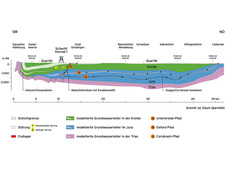The hydrogeological Situation
An important criterion for disposal is that the radioactive waste is not connected to the ground water. This is the case with the Konrad mine: mighty layers of argillaceous rock prevent the ground water from flowing into the mine.
For a repository, the Konrad mine's location is very favourable, as there are no direct permanent hydraulic connections between the biosphere and the repository. Connections that were generated by former exploratory drillings have been sealed effectively. After the period of operation, the shafts will be backfilled correspondingly.
No connections to the ground water
The ground water near the surface is mainly found in sandy deposits of the quaternary and is hydraulically connected to the local water bodies. The fossil water in the iron ore is separated by 160 to 400-m thick layers that are impermeable to water. The distribution of ground water in the subsurface geology is characterised by alternating water bearing layers and layers of low permeability or layers that are almost impermeable. In this way, the body of ground water is divided into several so-called ground water storeys with different hydraulic behaviour.

![]() Cross section through the modelled area (E-E’), with a depiction of the modelled migration paths
Cross section through the modelled area (E-E’), with a depiction of the modelled migration paths
The repository is safe for the long term
In order to analyse evidence of the long-term safety of the site, taking also into account unfavourable conditions and processes, calculations for a possible transport of radionuclides from the repository area into the biosphere were carried out for the long term. On account of the Lower Cretaceous being a mighty clayey barrier which seals large areas of the top of the storage horizon, there are only extremely few natural pathways to the ground-water bearing layers near the surface.
Fossil water reserves originating from the genesis of rocks
As in other mines, water can be found in the Konrad mine. In 2012, about 21.8 cubic metres of water were collected daily. Part of the water is reused underground, the rest is taken to the surface.
Over many years, the volume of the water found in the mine so far has remained within a narrow margin. Part of the water consists of up to 150-million-year-old fossil water that was enclosed during the genesis of the iron ore deposits. They have been taken into account in the model calculations to analyse long-term safety. Via shaft 2, the residual water flows into the mine from higher layers of rock. When the repository will be closed later on, the shaft will be sealed. Thus, this inflow does not affect the long-term safety of the repository.
State of 2017.03.30

